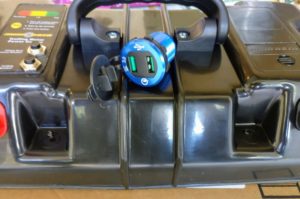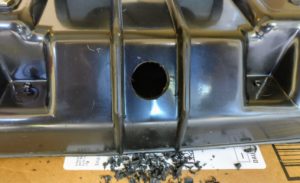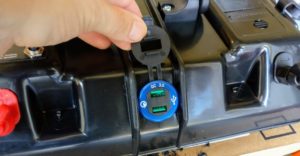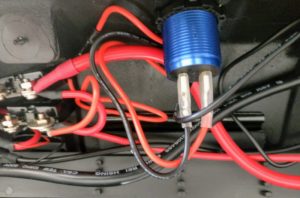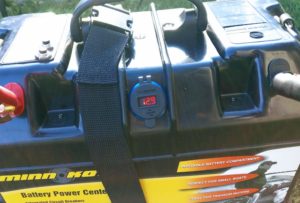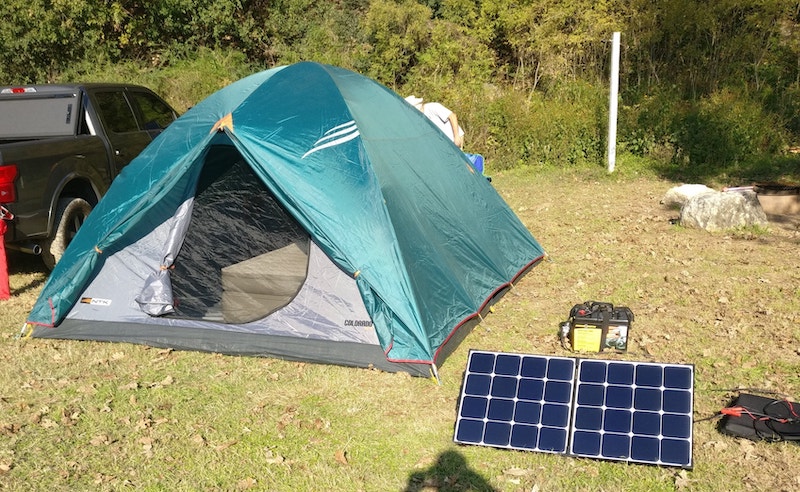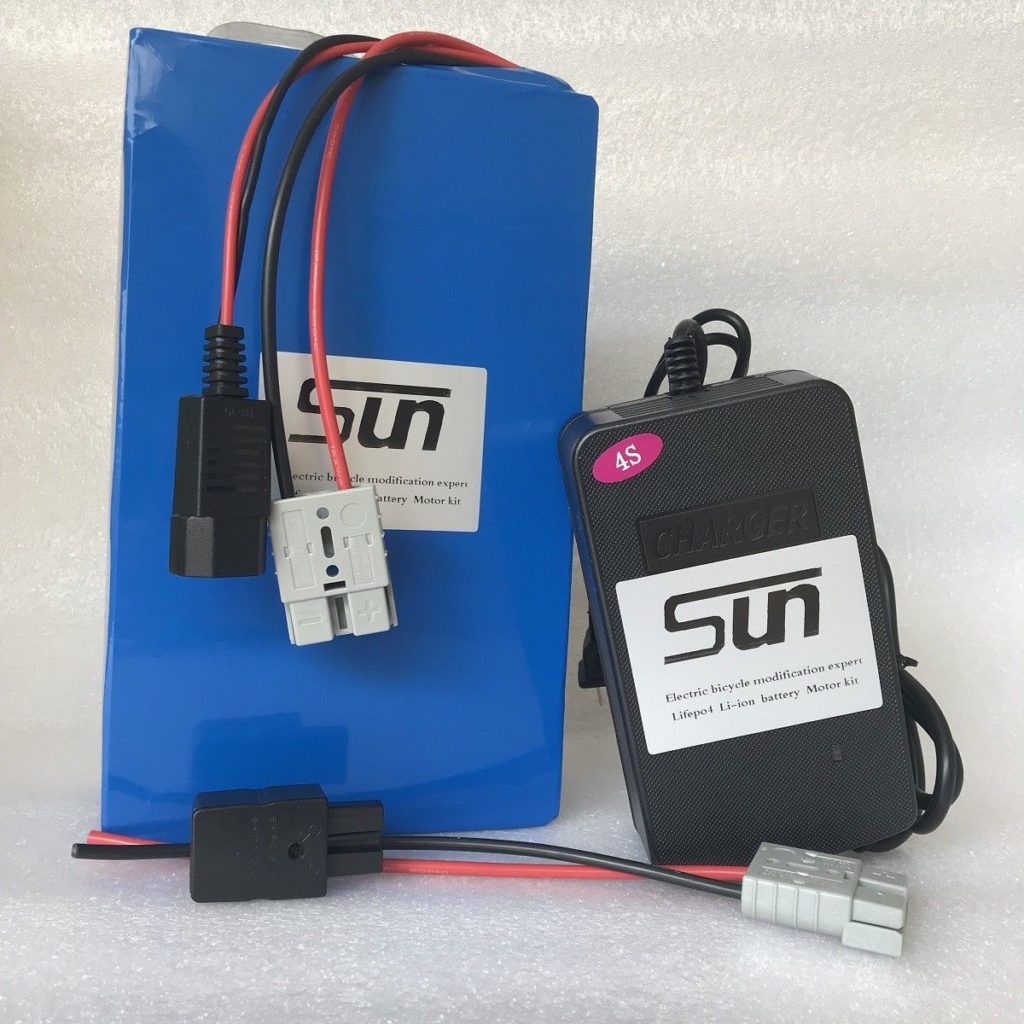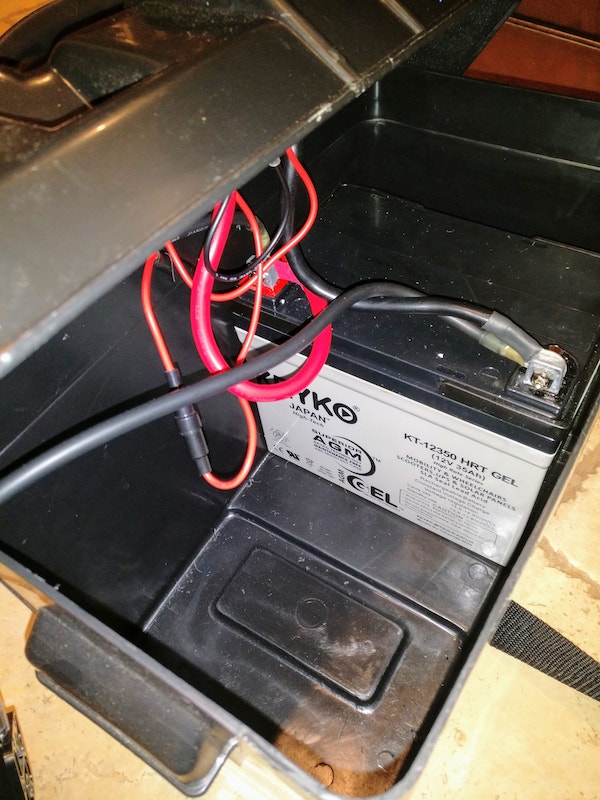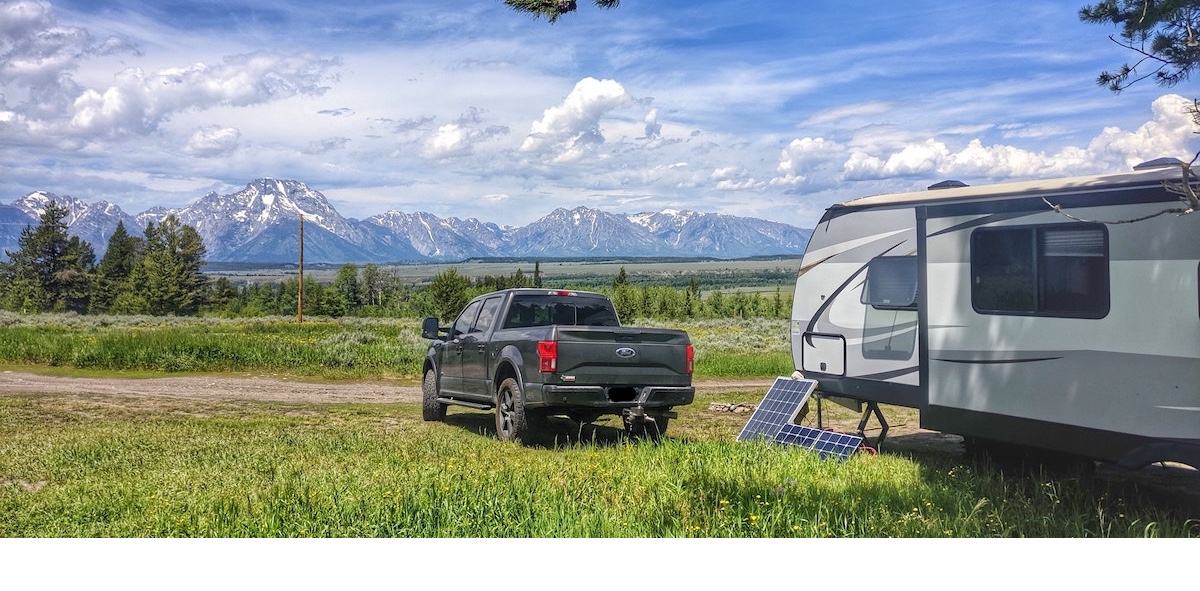
Using Our Solar Generator to Boondock/Drycamp in Bridger-Teton National Forest Across from the Grand Tetons.
What is a Solar Generator?
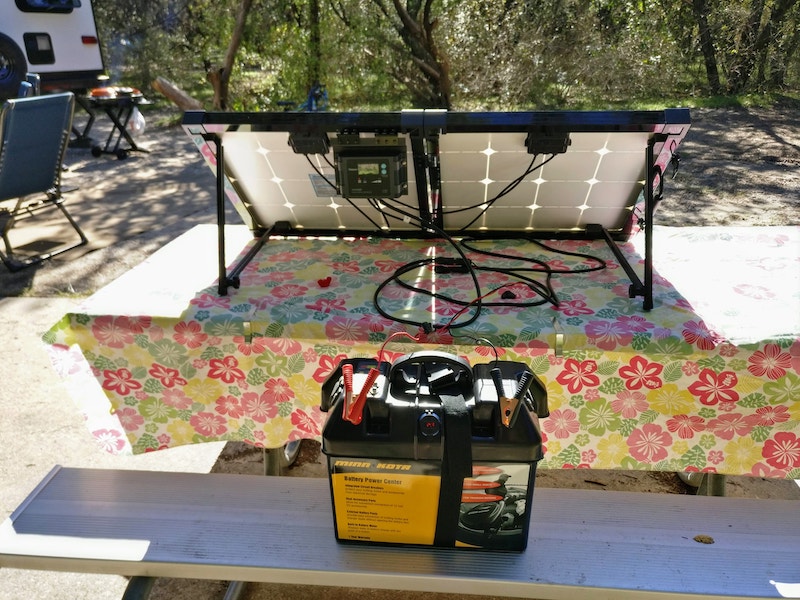
Do a search on Amazon and you will find a bunch of "Solar Generators" such as the Goal Zero Yeti, Ecoflow, and Renogy. Except for the Renogy Phoenix, most of these are just basically battery packs with USB ports and an inverter(for small AC devices) in a nice package that can be charged by a solar panel.
We purchased a cheaper PAXCESS PA100W unit about a year ago to use mostly as a USB charger for camping trips and other extended outings. We did use the AC plug to run a small fan for a few hours once.
*Disclaimer: Most if not all links on this page will be Affiliate Links. It doesn’t cost you any more to purchase through them, but it does help us to pay for things like website hosting and more tech & gadgets to write about.
No products found.
Without solar, you can charge these units from your house AC or car DC and then take them with you. Since they have AC outlets on them you can run smaller devices like a fan or charge your laptop. Some of these also have 12V DC Outlets so you can plug in and run car accessories that use the cigarette lighter plug.
Most of these units have a basic solar charger built-in and can be charged from a solar panel with the right cables. This is where they are getting their name "Solar Generator" from.
What sets them apart?
As you can see from the few samples above, the prices can range from a little over $100 upwards to over $3000 for the Goal Zero Yeti 3000.
The main difference between them will be battery size and type. A larger battery will let you run devices longer but this will also usually come at the expense of a heavy unit. Other features to look for are how many and what types of charging ports it will come with. (The Yeti 3000 weighs 68lbs and comes with a detachable roll cart!)
If you are looking to run AC powered devices, pay attention to how many watts the unit can output. The little PAXAcces can only do 100 watts. The Ecoflow can output 500 watts and the Yeti Goal Zero 3000 can output 3000 watts!
Watts = Volts X Amps
Look at the AC device you want to power and it should have an amp rating on its power adapter. Take that number and multiply it by 110 to get its approximate watts usage. If you are planning to run multiple AC devices on a regular basis, add their watts usage together to see what size solar generator you need.
Units with Lithium batteries will be lighter than units with SLA(Sealed Lead Acid) batteries. Lithium batteries will also last longer(aka more charging cycles).
Another measurement you will see these units listed with is Watt Hours. What is a Watt Hour? It is a measurement of power over time. If you run a 100 watt light bulb for 4 hours that equals 400 watt-hours. If you had a 500 Watt-Hour rated solar generator, you could run that 100-watt light bulb for 5 hours before running the battery out. (Note: while it's generally ok to run Lithium batteries down to 90%, SLA(Sealed Lead Acid) batteries should not be run down more than 50% or else you start to dimish the battery's capacity). Goal Zero goes into a deeper explanation here: https://www.goalzero.com/blog/what-is-a-watt-hour/
Later on, when we are looking at building our own Solar Generator, we will be talking battery capacities. Deep Cycle batteries are rated in Amp Hours(AH). To convert to Watt Hours, just multiply by 12. For example, a 12volt 50ah battery would equal 600 watt-hours or capacity.
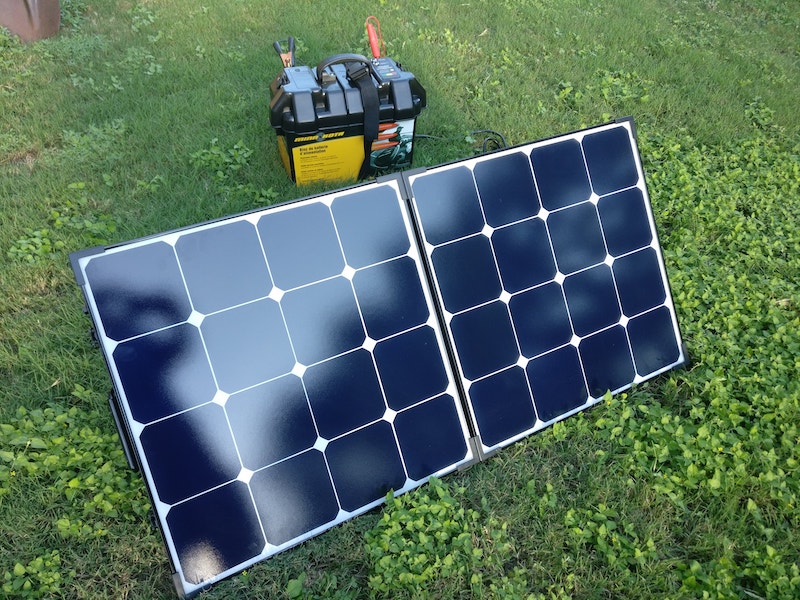 What about Solar Panels?
What about Solar Panels?
As mentioned earlier, you can charge these "Solar Generators" at home or in your car and then use them for a couple of hours (or days depending on the size) until the battery runs out. For example, many people use these Solar Generators to power CPAP machines while tent camping. This is also a great way to power a fan if you are tent camping in the Texas Summer!
But what if you need the extended use of your Solar Generator? Simply add the right sized solar panel and you can get a "free" recharge of your batteries from the sun! That's right, just about all of the Solar Generators for sale do NOT come with Solar Panels!
For our project, we picked the Renogy Eclipse 100 Watt Solar Suitcase for ease of portability, but there are many choices out there. Check out a fe woptions below:
No products found.
Build a DIY Solar Generator vs buying a Pre-made unit?
No products found.
Great question that has a few reasons WHY and maybe a reason or 2 why you would NOT build your own DIY portable power station.
Cost - A Goal Zero Yeti 400 Portable Power Station, 400Wh Battery Powered Generator Alternative with 12V, AC and USB Outputs costs about $400 (The Lithium version is about $600)
Here are the parts I used to build my Goal Zero Yeti 400 equivalent (this DIY system actually has 420 watt-hours of capacity)
(Keyko Batteries seem to be currently unavailable on Amazon but you can get a Mighty Max Battery 35AH U1 Deep Cycle AGM Solar Battery for $67)
MinnKota Trolling Motor Power Center $50
Quick Charge 3.0 Car Charger 12V/24V 36W Waterproof Dual QC3.0 USB Fast Charger Socket $18
Giandel 600W Modified Sine Wave Inverter 12V DC to 120V AC 20A Solar Charger $45
Core Tools CT126-LS-B Black Push Button Waterproof Switch $7.25
Suaoki Car Battery Charger 4 Amp 6/12V Fully Automatic $35 (I haven't actually purchased an AC to DC charger yet and have been solely charging from the Solar Panel for the last few months!)
My total parts total about $233 but add another $50 to $70 if you want or need to run a Pure Sine Wave inverter. So let's say $300 total. That is $100 cheaper with a little more capacity, but what are the other advantages and disadvantages to DIY vs pre-made Solar Generators?
Packaging - Pre-made Solar Generator Wins!
Look how nice that Goal Zero Yeti is packaged up vs my DIY! Nice and neet with cool led displays.
Warranty - Tie
With a DIY, there is no single source for your warranty but on the other hand, if one piece of your DIY Solar Generator fails, you could easily replace just that one part. Let's call this a tie.
Education & Learning - DIY Solar Generator Wins!
I have been building this project with my 10-year-old, explaining to him what each piece does and how we convert 12v to 110v. I have also learned a lot myself! We have a 33ft RV and plan to add solar to that in 2019.
Expandability - DIY Wins!
With my current Minn Kota battery case, I can easily add another 35ah battery and double my capacity. This would only cost me another $90(with cables) and now I would have an 840 watt-hours capacity system(although it would now be another 23 pounds heavier). You can also add external batteries to a Goal Zero Yeti, but you would have to carry it separately which would be less convenient.
Easy To Build
Starting with the Minn Kota Trolling Motor Battery Case make this build pretty easy. That case includes two 12v cigarette lighter ports. I added a Dual USB QC 3.0 Charging Port with Volt Display to mine. Most of my needs are 12v and USB so I don't always need the 120V Inverter. Put your battery in and connect the positive and negative cables, charge it up and you're ready to go!
Not shown in these pics, but I do have an on/off switch wired to USB QC Charger to save some battery when not in use.
I did use the modified sine wave inverter on a recent tent camping trip to inflate an Aerobed(sooooo comfy). This only took about 2 minutes and the battery was back to full charge after hooking back to the Renogy Solar Panel for a few minutes. We also use the battery to run some 12v 5050 LED Light Strips.
Future Upgrades
We are currently waiting for delivery of a 50AH LifePO4 Battery. These lithium phosphate batteries are about 1/3 the weight of Sealed Lead Acid batteries like our Keyko and can charge much quicker(our Renogy Solar Charger supports the LifePO4 charging profile). We will update this post once we have had some time with the new battery.
UPDATE!
Our new Suncycle 50ah LifePO4 battery arrived and it is currently soaking up the sun (charging). It weighs about 10 pounds less than the 35ah Keyko Gel we took out and there is easily room for one for to make 100ah total.
The cost for this new 50ah LifePO4 battery was about $270 and we now have 600 watt-hours.
[ratings]

